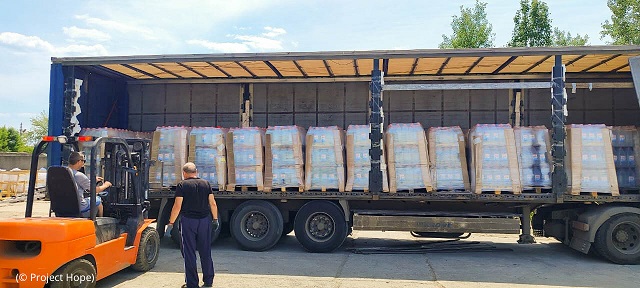Within hours of the destruction of the Kakhovka Dam in southern Ukraine, U.S. relief organizations and international partners rallied to provide emergency aid to families in Ukraine, like Yevheniya’s.
“We experienced this during active shelling, when my children and I spent a month without water and electricity,” she told UNICEF USA. “It’s very difficult to go through it again, especially for the children in summer.”
On June 6, an explosion destroyed the dam at the Kakhovka Hydroelectric Power Plant in southern Ukraine’s Kherson Oblast, triggering massive flooding that displaced thousands.
For families like Yevheniya and her three young children in Kherson, it meant scrambling to obtain safe drinking water again. Just as she did when Russia’s forces further invaded Ukraine last year, Yevheniya once again had to make contingency plans for the safety of her children.
“It reminds me of the start of the war, when you don’t know what to expect,” she said.

Streets are flooded in Kherson, Ukraine, June 7 after the destruction of the Kakhovka Dam. (© Libkos/AP)
Widespread damage
An estimated 16,000 residents face immediate flood risk as a result of the damage to the dam. In Kherson, at least five people have been killed, 43 others have been injured and 27 were still missing as of June 13.
Homes, farms and towns are at risk. People have been evacuated from Kherson to cities, including Mykolaiv and Odesa, and need assistance. There were initial concerns the dam’s destruction would affect cooling of the Zaporizhzhia nuclear plant upriver, though recent reports indicate the plant’s safety has not been impacted.
“We’re working tirelessly to get people the help they need today, and in the weeks ahead,” U.S. Agency for International Development Administrator Samantha Power said.
.@USAID is helping ppl affected by flooding in the aftermath of the Kakhovka Dam destruction. @WFP, w/ support from @USAIDSavesLives, has already provided 70,000 food rations to people in Kherson and Mykolayiv regions, and is feeding more people each day. pic.twitter.com/qlRFC81BEc
— USAID Ukraine (@USAIDUkraine) June 12, 2023
The U.S. government and relief agencies are responding to the humanitarian, environmental and economic consequences of the dam’s destruction. As of June 11, USAID had provided:
- Drinking water, hygiene kits and food to approximately 180,000 people.
- $538,000 in cash assistance to more than 5,000 households.
- Hot meals to 16,000 people in Kherson and Mykolaiv.
- 16,000 liters of fuel to support water rescue operations.
- Water purification systems, water pumps and boating supplies.
USAID and its partners also provided buses and fuel vouchers for emergency volunteers responding to the dam breach.

USAID humanitarian partner Project Hope is on the ground in the Kherson suburb of Antoniivka, Ukraine, providing safe drinking water to people affected by flooding caused by the destruction of Kakhovka Dam. (© Project Hope)
‘Unwavering’ support
On June 9, the U.S. Department of State announced a $437,000 contribution to the Organization for Economic Co-operation and Development’s plan to support Ukraine’s agenda for reform, recovery and reconstruction. The donation will fund an economic survey of Ukraine’s recovery needs to identify gaps and prioritize reforms.
The United States has already contributed $19.25 billion in budget support for the Government of Ukraine to pay first responders and government officials’ salaries, and to operate hospitals and meet pension obligations.
“The U.S. commitment to the Ukrainian people is unwavering,” Power said.
The exact cause of the dam’s failure and destruction is still under investigation.
Banner image: USAID is supporting Ukraine's emergency efforts to help those affected by the Kakhovka Dam's collapse, including by buying boats and water rescue equipment. (© Olexander Kornykov/Vgoru Media)
The original article is here on ShareAmerica.







COMMENTS0
LEAVE A COMMENT
TOP